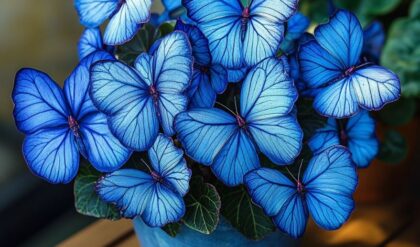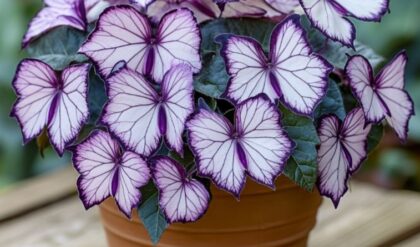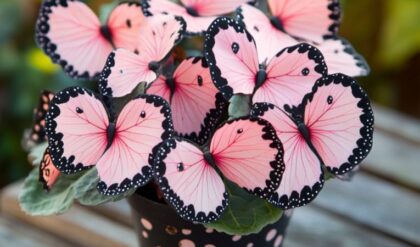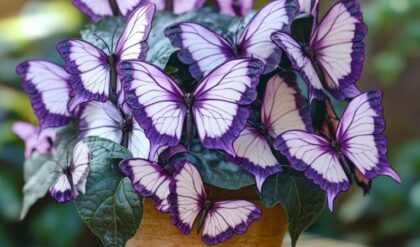Angel wing begonias are beloved for their stunning foliage and delicate blooms. These tropical beauties can add a touch of exotic elegance to any indoor space. While they have a reputation for being somewhat finicky, with the right knowledge and care, you can successfully grow thriving angel wing begonias. This guide will walk you through everything you need to know to cultivate these captivating plants.

Understanding Angel Wing Begonias
Angel wing begonias are a diverse group of plants known for their distinctively shaped leaves and colorful flowers. Before diving into cultivation techniques, it’s crucial to understand the unique characteristics and needs of these plants.
Origins and Natural Habitat
Angel wing begonias are native to tropical and subtropical regions of South and Central America. In their natural habitat, they grow as understory plants in humid forests, often clinging to rocky cliffs or nestled in the crooks of trees. This background provides important clues about their ideal growing conditions.
These plants evolved to thrive in environments with filtered light, high humidity, and consistently warm temperatures. The dappled sunlight filtering through the forest canopy protects their leaves from harsh direct sun. Meanwhile, the humid air and regular rainfall keep them well-hydrated without waterlogging their roots.
Understanding this natural habitat helps explain why angel wing begonias can sometimes struggle in average home environments. Our houses are often drier and have more extreme temperature fluctuations than these plants prefer. However, with some effort to recreate aspects of their native conditions, we can help them flourish.
Distinctive Features
The most striking feature of angel wing begonias is, of course, their foliage. The leaves are asymmetrical, with one side larger than the other, creating a wing-like appearance. This unique shape is not just for show – it helps the leaves efficiently capture light in their shadowy forest homes.
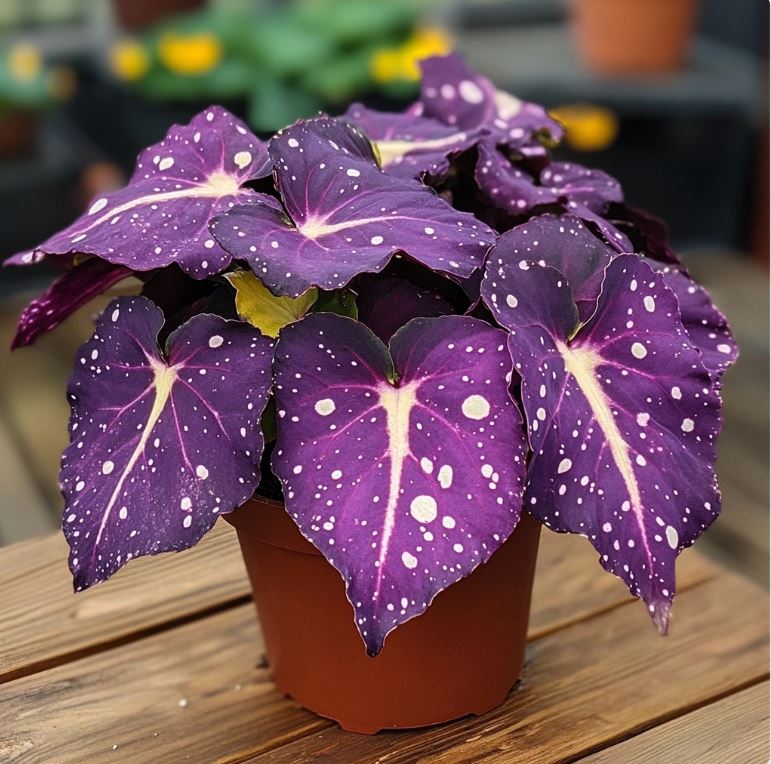
Leaf colors can vary widely depending on the specific variety. Some have deep green leaves with silver spots, while others might display shades of burgundy, bronze, or even near-black. Many varieties also have interesting textures, with raised bumps or hairs on the leaf surface.
While the foliage is the star of the show, angel wing begonias also produce lovely flowers. The blooms are typically small but numerous, hanging in clusters that can be quite showy. Colors range from white and pink to deep red, adding another layer of visual interest to these already stunning plants.
Growth Habits
In their natural habitat, angel wing begonias can grow quite large, sometimes reaching heights of 10 feet or more. However, when grown as houseplants, they typically stay much smaller, usually between 1-3 feet tall.
These plants have a naturally bushy growth habit, with multiple stems emerging from the base. As they grow, they tend to become somewhat top-heavy, which can lead to drooping stems if not properly supported. In the wild, this drooping allows them to root where stems touch the ground, creating new plants.
Understanding these growth habits is crucial for proper care. It informs decisions about pot size, pruning needs, and potential support structures to keep your plant looking its best.
Creating the Ideal Growing Environment
To help your angel wing begonia thrive, you’ll need to recreate aspects of its native habitat as closely as possible. This involves carefully controlling light, temperature, humidity, and other environmental factors.
Creating the perfect environment for your angel wing begonia is like conducting a delicate symphony. Each element plays a crucial role, and when they all come together harmoniously, the result is a thriving, beautiful plant.
Light Requirements
Light is perhaps the most critical factor in growing healthy angel wing begonias. These plants have evolved to thrive in the dappled sunlight of forest understories, so they prefer bright but indirect light.
In a home setting, an east-facing window often provides the ideal light conditions. The gentle morning sun is usually not intense enough to damage the leaves, while still providing plenty of brightness throughout the day. If you only have south or west-facing windows available, you’ll need to filter the light with sheer curtains or place the plant a few feet back from the window to protect it from harsh direct sunlight.
It’s important to note that while angel wing begonias need bright light to thrive, too much direct sun can scorch their leaves, causing brown spots or bleached areas. On the other hand, insufficient light will result in leggy growth and pale, washed-out leaves. You may need to experiment with different locations in your home to find the sweet spot where your begonia receives enough light without risking sun damage.
During the darker winter months, you might consider supplementing with artificial grow lights to ensure your begonia gets enough light to maintain healthy growth. LED grow lights are energy-efficient and can provide the specific light spectrum that plants need.
Temperature Control
Angel wing begonias are true tropical plants and are quite particular about their temperature range. They thrive in warm conditions, ideally between 65-75°F (18-24°C) during the day, with nighttime temperatures not dipping below 60°F (15°C).
Consistent temperatures are key. Sudden fluctuations can stress the plant, leading to leaf drop or stunted growth. This means you should keep your begonia away from drafty windows, air conditioning vents, or heating sources that might cause rapid temperature changes.

In most homes, maintaining these temperatures isn’t too challenging during the warmer months. However, winter can be tricky. If you live in a colder climate, you might need to move your begonia to a warmer spot during the winter or use a small space heater to maintain a consistent temperature.
It’s worth noting that while angel wing begonias like warmth, they don’t appreciate hot, dry conditions. If summer temperatures in your home regularly exceed 80°F (27°C), you’ll need to pay extra attention to humidity levels and possibly provide some cooling.
Humidity Management
High humidity is crucial for angel wing begonias. In their natural habitat, these plants are accustomed to humidity levels of 50% or higher. Unfortunately, most of our homes have much drier air, especially in winter when heating systems are running.
There are several ways to increase humidity around your begonia:
- Use a pebble tray: Place a tray filled with pebbles and water under your plant’s pot. As the water evaporates, it creates a humid microclimate around the plant. Just make sure the bottom of the pot isn’t sitting in water, as this can lead to root rot.
- Group plants together: Placing several plants close to each other naturally increases humidity as they release water through transpiration.
- Use a humidifier: A small room humidifier can make a big difference, especially in dry climates or during winter.
- Mist regularly: While not as effective as other methods, misting your begonia’s leaves can provide a temporary humidity boost. Just be sure not to mist too heavily, as constantly wet leaves can encourage fungal growth.
- Place in a humid room: Kitchens and bathrooms tend to be more humid than other areas of the house, making them good locations for humidity-loving plants.
Remember, while angel wing begonias love humidity, they also need good air circulation to prevent fungal issues. A small fan on low speed can help if the air in your home is very still.
Soil and Potting Essentials
The right soil mix and potting practices are fundamental to growing healthy angel wing begonias. These plants have specific needs when it comes to their root environment, and meeting these needs will set the foundation for robust growth.
Creating the perfect soil environment for your angel wing begonia is like preparing a cozy, nurturing home for its roots. The right mix will provide stability, nutrition, and the ideal balance of moisture and air that these plants crave.
Soil Composition
Angel wing begonias require a soil mix that is both well-draining and moisture-retentive. This might sound contradictory, but it’s crucial for the plant’s health. The soil needs to hold enough moisture to keep the roots hydrated, but it should also allow excess water to drain quickly to prevent root rot.
A good basic mix for angel wing begonias consists of:
- 1 part high-quality potting soil
- 1 part perlite or coarse sand
- 1 part peat moss or coconut coir
The potting soil provides a base of nutrients and structure. Perlite or sand improves drainage and aeration, preventing the soil from becoming compacted. Peat moss or coconut coir helps retain moisture while still allowing excess water to drain.

You can adjust this mix based on your specific conditions. If you tend to overwater, you might increase the proportion of perlite. If your environment is very dry, you could add more peat moss to improve moisture retention.
pH Levels
Angel wing begonias prefer slightly acidic soil, with an ideal pH range of 5.5 to 6.5. This pH level allows the plant to efficiently absorb nutrients from the soil.
If you’re unsure about your soil’s pH, you can test it using a simple soil pH test kit available at most garden centers. If the pH is too high (alkaline), you can lower it by adding small amounts of sulfur or peat moss. If it’s too low (acidic), you can raise it with a bit of garden lime.
Potting Practices
When it comes to potting angel wing begonias, there are a few key points to keep in mind:
- Choose the right pot size: Begonias prefer to be slightly root-bound, so don’t use a pot that’s too large. A good rule of thumb is to choose a pot that’s 1-2 inches larger in diameter than the current root ball.
- Ensure proper drainage: Always use pots with drainage holes. This is crucial for preventing water from sitting at the bottom of the pot, which can lead to root rot.
- Consider pot material: While plastic pots are lightweight and retain moisture well, terra cotta pots can be beneficial in very humid environments as they allow excess moisture to evaporate through the sides.
- Repot carefully: Angel wing begonias don’t need frequent repotting. Only repot when the plant has outgrown its current container, typically every 2-3 years. The best time to repot is in the spring, at the beginning of the growing season.
When repotting, be gentle with the roots. These plants have delicate root systems that can be easily damaged. Gently loosen the root ball and remove any dead or rotting roots before placing the plant in its new pot with fresh soil mix.
Watering and Fertilizing Techniques
Proper watering and fertilizing are crucial for maintaining healthy angel wing begonias. These plants have specific needs when it comes to moisture and nutrients, and meeting these needs consistently will result in lush growth and vibrant blooms.
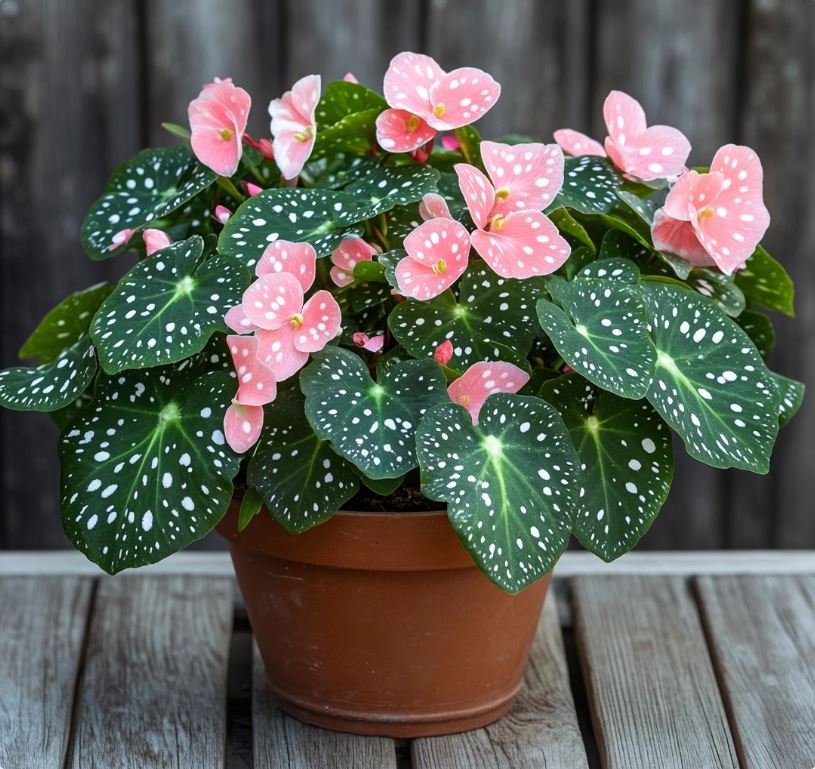
Mastering the art of watering and fertilizing your angel wing begonia is like learning a delicate dance. Too much or too little of either can throw your plant off balance, but get it right, and your begonia will flourish with vibrant health.
Watering Wisdom
Watering angel wing begonias can be tricky. These plants like consistently moist soil, but they’re susceptible to root rot if overwatered. The key is to find a balance that keeps the soil moist but never soggy.
Here are some guidelines for watering your angel wing begonia:
- Water thoroughly: When you water, do so thoroughly until water runs out of the drainage holes. This ensures that water reaches all parts of the root system.
- Allow soil to dry slightly: Before watering again, allow the top inch of soil to dry out. You can check this by sticking your finger into the soil up to the first knuckle.
- Use room temperature water: Cold water can shock the roots, so always use water that’s about room temperature.
- Water at the base: Try to avoid getting water on the leaves, as this can lead to fungal issues. Water at the base of the plant, directly onto the soil.
- Adjust for seasons: Your begonia will need more frequent watering during its active growing season (spring and summer) and less during its dormant period (fall and winter).
- Consider your environment: Factors like humidity, temperature, and light levels will affect how quickly your plant’s soil dries out. You’ll need to water more frequently in dry, warm, or bright conditions.
Remember, it’s better to underwater slightly than to overwater. Angel wing begonias can recover more easily from a bit of drought stress than from root rot caused by overwatering.
Fertilizing for Flourishing Growth
Angel wing begonias are relatively heavy feeders, especially during their active growing season. A regular fertilizing schedule will help maintain lush foliage and encourage abundant blooming.
Here’s what you need to know about fertilizing your angel wing begonia:
- Choose the right fertilizer: Use a balanced, water-soluble fertilizer with equal parts nitrogen, phosphorus, and potassium (like a 10-10-10 or 20-20-20 formula).
- Dilute properly: Always dilute the fertilizer to half the strength recommended on the package. Angel wing begonias can be sensitive to over-fertilization.
- Fertilize regularly: During the growing season (spring and summer), fertilize every 2-4 weeks. In fall and winter, reduce frequency to once a month or stop altogether if growth slows significantly.
- Apply to moist soil: Always apply fertilizer to moist soil to prevent root burn. Water your plant thoroughly a day before fertilizing if the soil is dry.
- Flush the soil occasionally: Every few months, water your begonia thoroughly without fertilizer to flush out any built-up salts in the soil.
- Watch for signs of over-fertilization: If you notice leaf burn (brown edges on leaves) or excessively leggy growth, you might be over-fertilizing. Cut back on frequency or further dilute your fertilizer solution.
Recognizing Water and Nutrient Issues
Being able to identify signs of watering or nutrient problems can help you adjust your care routine before serious damage occurs:
- Overwatering signs: Yellowing leaves, especially lower leaves; soft, mushy stems; mold on soil surface.
- Underwatering signs: Drooping leaves that don’t perk up after watering; crispy, brown leaf edges.
- Over-fertilization signs: White crust on soil surface; leaf burn; rapid but weak growth.
- Under-fertilization signs: Pale, small leaves; slow growth; lack of blooms.
By paying attention to these signs and adjusting your care accordingly, you can maintain the perfect balance of water and nutrients for your angel wing begonia.
Pruning and Propagation
Pruning and propagation are essential skills for any angel wing begonia enthusiast. These techniques not only help maintain the health and appearance of your plant but also allow you to expand your collection or share your beloved begonias with friends and family.
Pruning and propagation are like the yin and yang of begonia care. Pruning shapes and invigorates your existing plant, while propagation creates new life from the old. Mastering these techniques opens up a world of possibilities for your angel wing begonia journey.
The Art of Pruning
Pruning is crucial for maintaining the shape and health of your angel wing begonia. Regular pruning encourages bushier growth, prevents the plant from becoming too leggy, and can even stimulate more abundant flowering.
Here are some key points to remember when pruning your angel wing begonia:
- Timing: The best time to prune is in early spring, just as new growth is beginning. However, you can remove dead or damaged leaves at any time of year.
- Tools: Use clean, sharp pruning shears or scissors. Sterilize your tools with rubbing alcohol before and after use to prevent the spread of disease.
- Technique: Make clean cuts just above a leaf node (where a leaf attaches to the stem). This encourages new growth from that point.
- What to prune:
- Remove any dead, damaged, or diseased leaves and stems.
- Trim back leggy growth to encourage bushier habit.
- If your plant is getting too tall, you can cut back the main stems by up to one-third their length.
- Remove any crossing or rubbing branches to improve air circulation.
- After pruning: Reduce watering slightly until you see new growth, as the plant will need less water with fewer leaves.
Remember, while pruning is beneficial, avoid removing more than 25% of the plant at once, as this can shock the begonia.
Propagation Methods
Angel wing begonias are relatively easy to propagate, making it simple to create new plants. There are several methods you can use:
- Stem Cuttings:
- Choose a healthy stem with at least two leaf nodes.
- Cut the stem just below a node, making a clean cut with sterilized scissors.
- Remove the lower leaves, leaving just 2-3 at the top.
- (Optional) Dip the cut end in rooting hormone to encourage faster root development.
- Plant the cutting in a small pot filled with moist, well-draining potting mix.
- Keep the soil consistently moist and place the pot in a warm, bright spot out of direct sunlight.
- Roots should develop in 2-4 weeks.
- Leaf Cuttings:
- Select a healthy, mature leaf.
- Cut the leaf into wedges, making sure each section includes the thick main vein.
- Insert the cut edge of each wedge into moist potting mix.
- Keep the soil moist and warm, and place in bright, indirect light.
- Small plantlets should appear at the base of the leaf cutting in 4-6 weeks.
- Division:
- This method works well for mature, bushy plants.
- Carefully remove the plant from its pot.- Carefully remove the plant from its pot, being gentle with the roots.
- Inspect the root system and identify natural divisions or clumps. Use your fingers to gently separate these sections.
- Ensure that each division has a healthy root system and several leaves.
- Pot each division in its own container filled with fresh, well-draining potting mix.
- Water thoroughly and place in a location with bright, indirect light to help them adjust.
Conclusion
With the right care, your angel wing begonia can thrive and bring beauty to your home or garden. From understanding the nuances of fertilizing and watering to mastering pruning and propagation techniques, you now have the tools needed to keep your plant healthy and vibrant. Regular attention to signs of distress will ensure that your begonias remain lush and full of life. Happy gardening!

